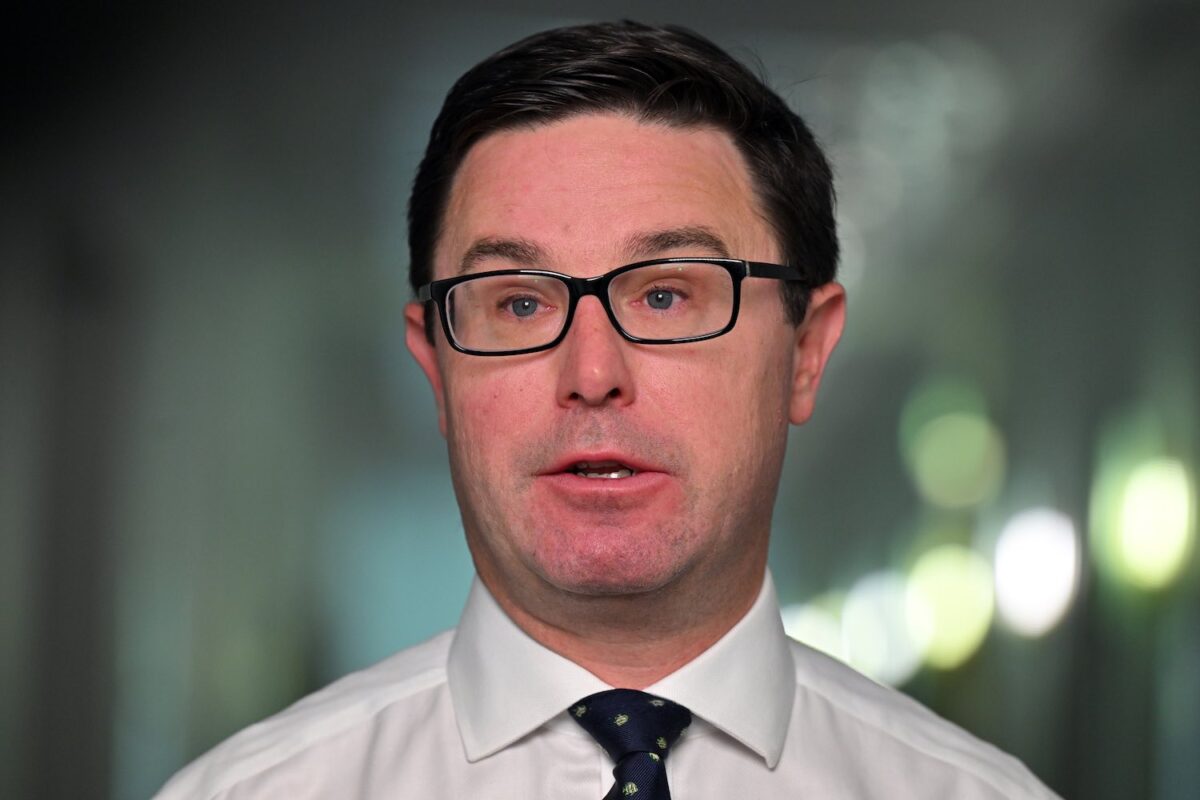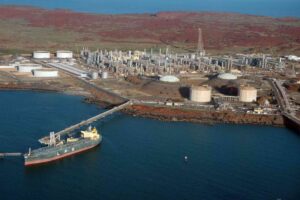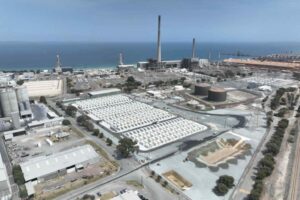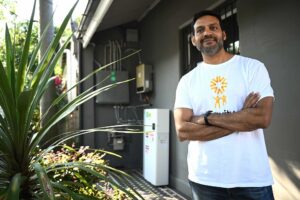This is getting just a little absurd. The federal Coalition’s pro-fossil and anti-renewable energy policy has not made much sense for many years, and the sudden embrace of nuclear hasn’t helped the endless contradictions.
Let’s just look at the last couple of days as an example. Nationals leader David Littleproud says the Coalition is not against renewables, but wants to stop the roll out of large scale wind and solar. “We won’t need large scale industrial renewable projects,” he says.
“The Nationals are not against renewable energy, but it should be in the right place, such as solar on rooftops in the cities,” the party wrote on its website after his visit to Wollongong.
We’ve heard this for years from the nuclear and fossil fuel lobby: They claim they are not against renewables, but they say they really don’t like wind and solar farms, and insist they can’t and won’t work. But let’s move on.
Littleproud turned up in Wollongong on Monday to campaign against the new offshore wind zone. He waved towards the ocean and the dozens of coal ships waiting to dock and said he is against floating offshore wind in the Illawarra, but apparently he is not opposed to fixed bottom offshore wind in Gippsland.
“They are fixed in Gippsland, this is floating,” he said, when asked to explain. Maybe it’s a whale thing. Floating coal ships good, floating wind turbines bad.
The Nationals don’t want new transmission lines either, but they say they don’t mind the one going from Gippsland to the Latrobe Valley. “The transmission lines that are required aren’t as necessary,” Littleproud said when asked. Nope, we don’t understand that either. Definitely not the whales though.
The Nationals insist the only way to power big industry is with something called “base-load” power, which they mean to be coal, gas and nuclear. Industry itself says this is not true. All the biggest energy users, such as the giant smelters in Queensland and NSW, are turning to wind and solar, with flexible and dispatchable energy to support it.
“We will hold onto our coal assets to allow that transition into nuclear and gas so that BlueScope steel can run,” Littleproud said, according to the ABC. “It can’t run on wind turbines and batteries. It simply can’t run on that.”
A day earlier, Bluescope manager Dave Scott said the opposite: “We will need large volumes of firmed, affordable, renewable energy. So, this (offshore wind farm) is a very important part of that mix. It’s a very important volume of renewable energy that will go towards supplying the energy that we need for decarbonisation.”
The Coalition also says it supports the Paris climate treaty, but not the interim targets that form an integral part of it, and which is essential to global efforts to try and limit global warming to an average 1.5°C. They are not concerned about the imposition of border tariffs and the destruction of the country’s export economy, flagged by Andrew Forrest.
The Coalition professes to be concerned about energy bills, but intends to stop the roll out of the cheapest energy technologies and replace them with the most expensive. In fact they have hit the trifecta of the costliest sources of power – nuclear, gas and carbon capture.
Littleproud even suggested that gas and carbon capture, another technology that for all intents and purposes in the electricity grid does not exist, are zero emissions technologies.
“We should have a slow transition from some of our coal-fired power stations to nuclear power plants that are zero emissions and firm that up with gas and carbon capture storage, which is zero emissions as well,” Littleproud told ABC Illawarra. They are not zero emissions.
All this might not matter much. For a population not particularly interested in the day to day thrust of political point scoring, nor the complexities of the energy industry and international climate policy, this all has the appearance of plausible deniability.
And any lingering doubt is quickly swamped by the fossil fuel propaganda machines that the Murdoch and other right wing media have become. The Coalition will be thrilled with the latest opinion polls, which has them leading Labor on a two party preferred basis.
But there is one part of this campaign that also makes absolutely no sense, and which may come unstuck for them – it’s the would-be marriage of nuclear and rooftop solar. The Coalition insists they are natural bedfellows, but it’s hard to see how it won’t end in tears.
“Why don’t we give priority to where they can make a difference and give energy independence to businesses and households, which is on rooftops where the concentration of power and population is,” Littleproud said on Monday.
Sure, let’s do that. It’s going to happen anyway. The Australian Energy Market Operator forecasts – under its Integrated System Plan – that the amount of rooftop solar in Australia is going to nearly quadruple from current levels of more than 20 gigawatts to nearly 72 gigawatts by 2040.
But here’s a question for you: How the hell do you suppose you are going to inject all your nuclear power stations into the grid with all that rooftop solar?
Rooftop PV is already going to be pushing grid demand to negative levels during the daylight hours in coming years, and by 2040 – which the Coalition now begrudgingly concedes is the earliest it can bring any nuclear plants on line – rooftop solar will be eating much of daylight grid demand.
And there’s really not much debate around that. The debate lies in how best to work around this massive “solar duck” and make sure there is enough cheap bulk and disptachable energy to keep the lights on in homes and businesses. Flexibility is the key. Always on “base-load” is just not going to fit.
There is, to be sure, a lot of debate around nuclear power and whether it is really, really, really, really expensive, or just really, really expensive.
(Opposition treasury spokesman and former energy minister Angus Taylor reckons nuclear won’t need subsidies, but we’d love to be told of a single nuclear plant anywhere in the world that was built without direct government money or subsidies.)
What is certain is that if nuclear is not able to run “always on”, then it is even more expensive, or it needs to be supported by massive amounts of storage. In reality, every energy power source needs support and back up.
This is not new. The introduction of nuclear into countries like the US and France caused the construction boom in pumped hydro, because nuclear – like any other power technology – needs that back up in case it fails, or if it produces more power than is needed.
In Ontario, the nuclear nirvana often cited by the Coalition, the provincial government has just ordered two of the world’s biggest batteries to soak up the excess nuclear power, particularly in the middle of the day when it’s not needed – and they don’t have much rooftop solar.
In France, the government entity EdF – already bailed out on multiple occasions because of the soaring cost of nuclear – is now being forced to switch off nuclear in summer because there is not enough demand. France has long exported excess nuclear to neighbouring countries, but in summer – with their own rooftop solar – they don’t need or want it.
Australia, of course, is an island, so there is no export opportunity for nuclear, unless the Coalition wants to go against its “no new transmission” mantra and build massive sub-sea transmission lines to Indonesia, and the power lines across the country to go with it.
Some states have already reached the point where rooftop solar matches total grid demand. It has happened in South Australia and will soon happen in Western Australia.
The market operator flags that it will then occur in other states such as Victoria, NSW and Queensland. One of its biggest problems is managing minimum load. That last thing it needs is more “always on” baseload. That’s why the coal generators are leaving the grid, or getting paid to operate with the same capacity factors as solar plants.
In the 2030s the minimum demand issue is expected to be at least partially solved by the uptake of electric vehicles, electrification of homes and businesses, and the growth of green hydrogen. But in a Coalition Australia, where EVs are mocked and not encouraged, and gas and fossil fuel retain their primacy and are force fed into homes, that won’t happen.
So, what is the Coalition plan? It will need to switch something off. Will that be nuclear, or will the Coalition reach into the home and switch off your rooftop solar? It may have no choice, unless it imposes the cost of extra storage – something that the Coalition insists is not needed with what Littleproud calls “baseload firming” (itself a contradiction).
Littleproud can’t tell you, of course, because he hasn’t thought it through. If he struggles to complete a whole sentence without getting confused and contradicting himself, then he’s unlikely to be able to produce an energy policy right now that doesn’t eat itself alive.
This push for nuclear makes no sense. The energy industry knows it, and the Coalition probably knows it too. Or at least they should. The rooftop solar industry has already eaten the lunch of the Australian coal industry, and is going to do the same to nuclear before it has even sat at the table. And the Coalition is going to have to wake up to that as well.








